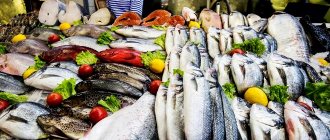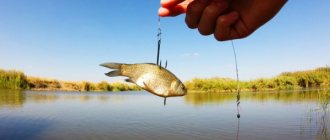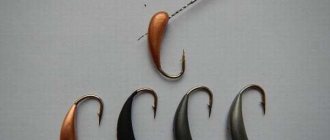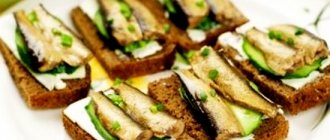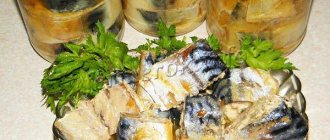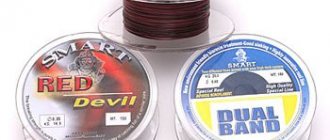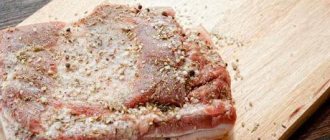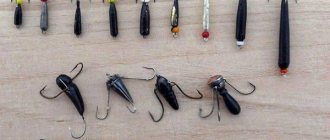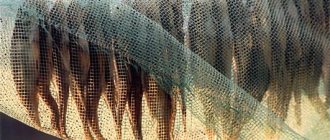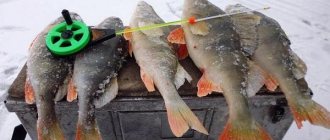Mormyshka
is a small weight of a certain shape, size and color, made of tin, lead, copper, tungsten, stainless steel or their alloys, with a hook fixed in it and a hole for tying to a fishing line.
The shapes of jigs are varied, but some of them are the most popular - “pellet”, “droplet”, “ovsinka”, “klopik”, “bean”, “lentil”, “cone”, “rhombus”, “grushka”, “uralka” , “ant”, “goat”, “devil”, “witch”, “dracena”, “nymph”, etc.
Content
- 1 Description 1.1 Material
- 1.2 Shape, color, size, weight
- 1.3 Hook
- 1.4 Equipment
- 2.1 Jigs for fishing with attachments
- 3.1 Basic techniques for playing with a jig
- 4.1 Sawing the jig
Characteristics of a homemade nozzle
When making jigs with your own hands, the fisherman must determine the main criteria for the operation of the tool. The performance criteria are expressed by the primary characteristics of the product, which determine its final version of the game. The main characteristics include mass .
The weight of the bait is classified as heavy and light. Lightweight - suitable for playing fine and delicate games. They are made from plastic, nylon and metal alloys. The weight of such an accessory ranges from 1 to 30 grams.
Heavy - designed for catching shy and cautious fish. They have a stable and even game. They are made purely from metal and its alloys.
Another important characteristic is the shape. The shape of the bait is quite varied, but in essence it should resemble a small insect or its larva, which are usually included in the diet of all types of fish. The most common shapes are pellets, barrels, crescents, cones, and droplets. These shapes can be either voluminous or flattened.
The third characteristic determines the color spectrum of the bait. Typically, promising colors are those that resemble the color of the fish's natural food source. As a rule, black, red and dark green are considered working colors. During certain periods, fish perfectly perceive instruments that have silver and golden tones.
An important parameter for jigs is the hook. The attractiveness and play of the weight depend on its type and size. To assemble the product, depending on the final purposes of the tool, single- and double-bend hooks, as well as miniature tees, are used. Sometimes purchased hooks are modified by first tempering them by heating over a fire and bending their forend to the required angles, subsequently subjecting the structure, already formed to the required requirements, to hardening.
Description
Material
Mormyshka
As you know, the overwhelming majority of jigs are made from either lead or tungsten. Of course, there are other metals (for example, silver) or alloys (for example, Wood's alloy) from which jigs are made, but in their shape and play they are not much different from lead, and the main difference is that they have greater specific gravity or increased resistance to corrosion. It is also very common to find jigs, which consist of a crown (usually white or yellow metal) soldered into lead.
Which material should you prefer?
- Lead
is the most versatile metal, which allows you to make jigs of various types and varying complexity, and, most importantly, this can be done at home. The main disadvantage is that, with small sizes, the jig is quite light and when fishing at depth, the jig sinks for too long, and when fishing in the current it quickly gets carried away...
- Tungsten jigs
are much heavier in specific gravity than lead jigs of the same volume. But, unfortunately, the main disadvantage of tungsten is that it is very difficult to process, although recently tungsten jigs of various shapes have begun to appear. Tungsten jigs are most suitable for fishing at depth and when fishing in medium or fast currents.
Shape, color, size, weight
The history of the development of the jig goes back several decades, and during this time the main types of forms have been developed, which have become classic today.
What shape of jig is optimal? This question is asked by any novice angler and hopes to hear a definite answer. But just as there is no universal attachment or spinner, there is also no single jig shape that would be ideal in any situation.
Of course, there are certain criteria when choosing the shape and color of a jig, but the most important criterion should be the experience of the fisherman himself. Today there are all kinds of jigs on sale and the choice is huge, but choosing that one jig that will be “super catchy” is not easy. The fisherman himself must experiment with different types of jigs and draw conclusions. After just one season of active fishing, he will have a lot of information about the catchability of certain types of jigs, depending on the reservoir and fishing conditions.
After this, the fisherman often concludes that there is no ideal jig available for sale and that he needs to create or modify the jig himself so that it is most suitable for specific fishing conditions. And this approach to choosing a jig is the most correct!
But still, what type of jig should I start with? We can only say one thing – from anyone! Take any jig that you like and try it in action. The only thing I would like to say is that it is better to start with small jigs and preferably dark (black) in color.
As “quite universal” jigs for beginning anglers, we can also recommend “oat” shaped jigs. As for the choice of jig color, it can be noted that light jigs are best used when fishing in muddy water or in cloudy weather, and dark jigs are best used in light water or when fishing during the day in sunny weather, and also if there is a light (for example, sandy) material. bottom.
When fishing at great depths, color is not an important criterion at all, since the fish simply does not distinguish it, but reacts mainly to the vibrations (play) of the jig.
The size and, accordingly, the weight of the jig is selected based on the fishing conditions. In this case, it is necessary to take into account the depth of fishing, the presence of a current and its strength. When fishing in a current, the weight of the jig should be such that it is possible to lower the jig into the water and make at least one full retrieve, that is, lower the jig to the bottom and raise it to the surface.
Recommendations for choosing jig weight:
- for catching bream and roach, a small but heavy jig is best suited;
- heavy jigs are good for fishing on relatively thick fishing lines with bait;
- heavy jigs allow you to quickly deliver the bait to the right place;
- small jigs (up to 0.25 g) attract small fish at a depth of up to 2 meters;
- large jigs (more than 0.25 g) attract predatory fish at a depth of 3-4 m;
- on the first and last ice, the use of large models of jigs is justified;
- a light jig provides a more delicate game.
Recommendations for choosing the color of the jig:
- the silver, black or red body of the jig serves as an additional guide for fish in search of food;
- black jigs are the most versatile, but they are most effective when used in the spring;
- Copper-colored jigs are suitable for fishing at great depths;
- for catching roach and perch, choose medium or large jigs of brown, dark green, dark purple, brass color;
- the lighter the water, the colder the color of the jig should be;
- the more snow on the ice, the lighter the jig should be, and the less snow, the darker the bait, even black;
- In the morning in shallow water it is better to fish with a shiny bait, in the middle of the day with a dull one;
- at a depth of over 10 meters, the color of the jig does not matter.
Recommendations for choosing a jig shape:
- In order for the jig to attract the attention of the fish with its action, it must be sufficiently voluminous and capable of generating noticeable vibrations;
- a jig flattened at the top and bottom raises a cloud of turbidity on the muddy bottom;
- “droplet” and “pellet” create light fountains of turbidity at the bottom;
- a flat jig forms noticeable clouds of turbidity on the bottom and at the same time seems to disperse them, suitable for catching roach and perch;
- nodding movements are effective with the “Ural” jig and the “ant”;
- the cone-shaped jig, having sunk to the bottom, enters the upper layer of silt;
- “droplet”, “ovinka”, “pellet” are irreplaceable in the wilderness;
- perch, roach, bream, chub are caught using the “devil”;
- jigs in the shape of a droplet or a ball are the most versatile.
Recommendations for choosing jig size:
- The size of the jig is selected depending on the depth of the fishing spot and biting activity;
- when the bite is very weak, super-small tungsten jigs with a diameter of 1.6-1.8 mm are often used;
- Fishing with small jigs takes place in still water, at depths of no more than 2 meters.
Hook
The hook is the most important element of the jig. If you have picked up a catchy jig and the bites follow one after another, but each time there is either a hit on the lips or a slip when hooking (fishing), then this means you have a bad hook!
Unfortunately, with all the richness of the choice of types of jigs, the weakest point is the hook. With rare exceptions, you can find jigs with hooks from Gamakatsu, Mustad, VMC, etc.
Always check the sharpness of the jig hook, it should be maximum. To do this, it is recommended to always take a hook sharpener with you.
If the hook is sharp enough, and the number of slips increases, then you need to slightly bend the hook tip towards the jig.
If possible, it is better to choose steel wire hooks rather than hardened iron. This is due to the fact that with a “dead” hook, the forged hook simply breaks and you lose your favorite jig, but with a wire hook there is a chance that the hook will simply straighten out and you will release the catchy jig.
Equipment
By equipping a jig, we mean equipping the shank of the hook with various cambrics or beads. Equipping a jig is especially important when you are fishing without a nozzle.
The simplest equipment can be considered when a piece of wire insulation (cambric), most often red or yellow, is put on the forend. When fishing without bait, it is better to place one or two beads in front of such a cambric.
It should be noted here that the color of the beads is not of fundamental importance; their main task is to add vibrations when playing with a jig in the water, which attract fish and make them instinctively grab the jig.
If fishing is carried out with a nozzle, then in this case you don’t have to equip the hook shank with additional cambrics or beads at all.
General rules
Mormyshki can be heavy or light
Heavy ones are needed in cases where the fish bites very carefully and the size of the bait should be as small as possible. To make a heavy jig
These materials have one significant drawback - they are poorly processed. For this reason, the edges of the holes in the jig cannot be made smooth, and when hooking and landing fish, they damage the fishing line. It is not difficult to get rid of this drawback - you need to insert a piece of radio insulation into the hole. Light jigs are used in cases where delicate play is needed. They are made of plastic and elastic nylon. - about 1.5-2 mm, and the weight ranges from 0.1 to 35 g. If you need ease in your upcoming fishing, you can make tungsten jigs with your own hands - you’ll hit the bull’s eye.
When, hearing, smell and touch, as well as vibrations in the water. A good bait should perfectly imitate the behavior of the food in order for the fish to be interested in it. Some anglers believe that the shape of the bait does not matter to the fish. This is true - the fish eat bait in the form of crackers, porridge balls and other things. However, the behavior of the bait is of great importance for the fish - that is, the game of the fisherman. A
Therefore, it is important to know what kind of play a certain shape provides. In addition, most bites occur at those moments when the jig is in close proximity to the bottom
- the jig, flattened at the top and bottom, raises the mud and plays in close proximity to the bottom;
- a jig in the shape of a drop or a shot creates fountains of turbidity when it hits the bottom;
- a flat jig forms clouds of turbidity and at the same time slightly disperses them;
- The “Ural” jig and the “ant” almost do not deviate from the vertical during the game, but their hooks turn to the right and left;
- The “barrel” and “devil”, with barely noticeable play, bury their hooks in the mud. When moving vertically, it does not deviate to the side;
- The cone-shaped jig, upon contact with the bottom, enters the upper layer of silt. On the surface of the bottom there remains only a hook with a bloodworm attached, onto which the fish goes without fear;
- droplets, oats and pellets create very weak vibrations in the water column. In the wilderness, when the delicacy of the game is of great importance for fishing, such jigs are irreplaceable.
If a novice fisherman plans to make jigs with his own hands, he should not forget about the importance of the shape of the bait. – scientifically proven fact
Moreover, some fish distinguish even more colors than humans eat. Even in the dark, they are able to see different shades while we only see shades of gray. Based on this, we can conclude that a catchable jig should resemble in color the type of food that the fish eats. . Therefore, completely or partially red jigs are often lucky. Various bugs, crustaceans and leeches are dark in color, often black. Therefore, fish often bite on jigs of this color. The fry are golden or silver in color. Accordingly, for fish that hunt fry, . Many fish also eat algae. For fishing with them
Hook
Another important point is the hook of the jig. It must be well sealed, and the probability of the fish falling off the hook is high. . If there is only a double-bend, you need to carry out some manipulations with it - release the tip on the fire and bend it with pliers until it is flush with the fore-end. After this, harden the hook again. After purchasing hooks, they need to be checked. One package can contain both good and bad hooks. , and unheated ones are soft. The strength of the hook is determined by pressing the nail on the middle of the shank. A good hook bends only with very strong force. To check the sting, you need to stick it into a block of lead, and then try to bend it by holding the forend. , that means it's good. Also, the tip must be very sharp to ensure strong strikes. Forged hooks are stronger than their counterparts with a forged section, so it is advisable to use them.
Types of jigs
It is almost impossible to talk about all the types and forms of modern jigs, due to the fact that they are constantly being improved. Perhaps the most common, classic form of jigs is a ball (“pellet”) and a drop (“droplet”). Of course, there are a huge variety of other forms: various “ants”, “devils”, “goats”, but a novice fisherman first needs to master simpler models.
According to the method of fishing, jigs can be divided into two categories:
- jigs for fishing with attachments;
- jigs for baitless fishing, the so-called “reelless”.
Jigs for fishing with attachments
Types of jigs Jigs “shots” are mainly used for fishing with a nozzle and come in two types: with a through hole and with a loop.
These jigs are made from lead or tungsten (there are copper and silver models). Recently, tungsten jigs have become more popular because they weigh more than lead jigs, although they are more expensive. For fishing at shallow depths, there is no fundamental difference which lead or tungsten jigs to use. If fishing is at great depths, and there is also a current, then tungsten jigs are often more effective. On the other hand, when fishing without bait, lead jigs often work much better than tungsten jigs.
When choosing tungsten jigs with a hole, it is better to choose those with a cambric inserted into the hole, since tungsten is much harder than lead and the cambric will protect the line from rubbing against the edges of the hole. Another important point is the size of the jig. For most reservoirs and fishing conditions, pellets with a diameter of 2.5-3 mm are suitable. Larger jigs may be needed for fishing at depths of more than 5 m or in currents. Miniature jigs with a diameter of 1.5-2.2 mm. used mainly for sport fishing.
The second popular form of jig is a drop, the so-called “droplet” jig. Tungsten drop jigs are used both when fishing with bait and in fishing without bait. The criteria for choosing a “droplet” jig are similar to the selection of spherical “pellet” jigs. You just have to take into account that a “droplet” of the same diameter as a “pellet” has more weight, so under the same conditions you need to use droplet jigs of a smaller size than “pellets”. Otherwise, these jigs are very similar, and they can be used with approximately equal success for fishing with bait for various types of fish in different conditions.
Regarding color when choosing a jig, for fishing with a bait the color of the jig is rarely the determining factor. Under certain conditions, dark jigs of a natural color are more catchy; sometimes jigs with a shiny surface bring success. Therefore, it’s a good idea to have jigs of different colors in stock and directly experiment while fishing which jig and what color will be more catchy.
Nozzle-less jigs or “reelless jigs”
Reelless jig equipment These jigs differ significantly from models used for fishing with bloodworms or other natural baits.
In fishing with baitless jigs, the main thing is the action of the bait, which is noticeably influenced by cambrics, beads, chains and other “decorations” placed on the hook. As a matter of fact, the attractiveness of bait for fish largely depends on them. Nevertheless, the size, shape and color of the body of a nozzle jig often play an equally important role, and the variety of options here is very large. Most “reelless” jigs are designed for gliding play: the role of a kind of wing is played by the flattened front part of the jig’s body. This bait has its own game, which complements the vibrations set by the guard. For fishing without bait, lead jigs are traditionally used: “ant”, “devil”, “uralka”.
Usually, nozzle jigs are made of lead: in this case, the high specific gravity of tungsten becomes a disadvantage. True, tungsten models with an enlarged flat also appeared, but their performance depends more on the round plates placed on the hook. Moreover, you must constantly ensure that the cambric that holds the records in place does not limit their freedom of movement, otherwise the game will be lost. Most of these baits have a soldered hook, to the eye of which the fishing line is tied. This type of fastening is more reliable than the traditional one where the fishing line is passed through a hole in the body of the bait.
As a rule, “reelless” jigs are larger than “regular” jigs and are designed for catching more marketable fish. “Reelless” baits work well on large roach, perch, and bream. Since these baits largely imitate aquatic insects and their larvae, the main colors of jigs are dark green, purple, brown and black. Copper-plated and gold-plated rewinders also work well.
Much more varied than the colors of nozzle-free jigs are various refills - beads, seed beads, cambrics and others. Often the final result of fishing depends on the color or even their shade. Often two-colored, striped and asymmetrical beads are used, which play when wired. According to the experience of many anglers, cognac colors, dark brown and purple, clear or yellow striped, work well on a reelless bait. In general, contrast often gives results.
The classic colors of beads on reelless fish are white, yellow, red and their combinations, sometimes with the addition of green: this range works on most bodies of water. In general, many variations have been invented, and although they, first of all, “catch,” of course, the buyer, this variety still makes sense.
There are many models of jigs for baitless fishing with flies tied to a hook. But this is exactly the case when the bait is more designed for the attention of the angler, rather than the fish. The exception, perhaps, is the only jigs made by fly fishermen and subtly imitating some kind of aquatic insect. Such jigs catch very well, but are extremely rare and, as a rule, are made only to order.
Winter jigs
Winter jigs are used for catching not the most active fish. They are small in size and colored in such a way as to attract fish from afar. Usually they put some kind of attachment on them.
Types of winter jigs:
- jig for catching perch. Its dimensions range from 2 to 6 mm; usually bloodworms are attached to it.
- jig for catching pike perch. This is the largest winter jig. It has a slightly oblong shape and is usually painted white.
- jig-clamp. This bait is used when fishing for small bait, which is very difficult to put on a hook.
- nozzle jigs. The main difference between a jig for fishing without a nozzle is the ratio of the body of the jig, hook, beads and cambrics, which additionally attract fish. Fishing with a baitless jig is a simple, productive and at the same time economical way of fishing. The most common types of such baits are: “ant”, “uralka”, vertical jigs.
Summer jigs
Summer jigs are large in size. They differ from winter ones in color. The most widely used jigs in the warm season are red-brown tones. In summer, they are good for catching crucian carp, perch, and pike perch.
You can fish with a summer jig anywhere. You just need to find a promising place and fish it. The catches of such gear will always be greater than those of floaters in the same place. By conducting a jig like winter fishing in different horizons of a reservoir, you can seduce even the most passive fish, which cannot be done with float tackle.
Purpose and methods of use
The bait got its name from the amphipod crustacean, which lives in fresh water bodies and makes up a high percentage of the food supply for fish. The “game” of the bait is similar to the movements of a jig. Miniature metal baits are used to search for active fish. The jig brings good results when exploring vast water areas and different depth layers. Unlike float tackle with a hook, the bait is more mobile and requires a special fishing rod. For jig fishing, select lightweight sport-type fishing rods that fit well in the hand without hindering the movement of the hand. The thickness of the fishing line rarely exceeds 0.12 mm, even if fishing is carried out at great depths.
To learn more:
Review of Kosadaka wobblers for pike and perch
The variety of fish species that are ready to eat bait reaches almost 80% of the population of fresh water bodies. Common representatives of the winter catch are perch, ruffe, roach, silver bream, and bream. Carp and crucian carp are much less likely to be caught using jigs due to low activity during the freeze-up period.
Jig fishing technique
Fishing technique with a jig *Having found the desired depth of descent, place one or more bloodworms, thistles or mayflies on the jig. The jig is lowered to the bottom, controlling the descent with a nod. Then shake the jig at the bottom, knock 5-10 times so that a cloud of turbidity rises. Start lifting with rocking at a fast pace with an amplitude of oscillation of the rod tip of 1.5 cm. Raise the jig to a height of 50 cm and wait a pause of 2-3 seconds. Lower the jig to the bottom on a bent nod. After 5-10 cycles, you need to try to change the pace of the game and reduce the amplitude of vibrations, raise the jig higher.
- Lower the jig with bait to the bottom. Raise the jig 1-3 cm and begin a leisurely rise, playing with the tip of the fishing rod at a pace of 90-120 times per minute and an amplitude of 0.5-1 cm. Stop the rise every 3-5 cm, shaking the jig 2-3 cm. At a level of 60-70 cm from the bottom, finish lifting and lower the jig for a new cycle.
- Lower the jig to the bottom. Swing the jig, lifting it 0.5-1 cm above the bottom. After 3-4 cycles, pause for 5-7 seconds. All movements should be slow. After 1-2 minutes, direct the fishing line to the edge of the hole. Without stopping playing with the jig, pull the line to the other edge of the hole. This is a good technique for fishing with a jig when the fish are sluggish in the dead of winter.
- Lower the jig to the bottom. Raise it 3-5 cm and play it like a spinner 3-5 times. Hang above the bottom and pause for 2-4 seconds. Start lifting, slowly accelerating, and leave the jig 40-50 cm above the bottom. Then lower it in jerks by 2-3 cm with a pause of 2-3 s. Leave on the bottom for 3-4 seconds. This technique of fishing with flat jigs is suitable when the fish is quite active.
- Reelless jig fishing. The jig sinks to the bottom. Then a slow rise begins with trembling oscillations, the rate of which is 100-300 times per minute, the amplitude is no more than 1 cm. The slower the rise and the shorter the amplitude of the oscillations, the more often fish bites occur. If there is a failure in tempo, it is better to start lifting the jig from the bottom again. This technique of fishing with a jig brings success all winter, with the exception of the middle of winter - the time when fish are most unbiting.
- The jig is raised above the bottom by 0.6-1 m, and the game begins. The jig is lowered by 2-3 cm and, holding it, pause for 2-3 seconds. During the pause, they rock gently. Having reached the bottom, pause for 3-4 seconds and move the jig, repeating this 5-6 times. The jig is slowly lifted from the bottom 0.5-1 m.
- The jig is lifted from the bottom slowly. Swing the tip of the winter fishing rod at a rate of 10-20 times per minute with an amplitude of 2-3 cm. Stop the rise after 15-20 cm and pause for 2-4 s. You can not raise it above 60 cm.
- Moving the jig on the bottom, he moves the tip of the winter fishing rod from edge to edge of the hole crosswise. This jig fishing technique is called “crossing the hole.” White bream, ide and chub are caught.
This jig fishing technique is not exhaustive. An angler can look for his jig fishing technique. But we must also be guided by general principles. The technique of fishing with a jig should depend on the time of year, the fish you are going to catch, and the weather. If there is no oxygen deficiency in the reservoir, when there is first ice or in the spring, jig play can be more active. If there is a lack of oxygen and fishing with a jig in the middle of winter, before the snow begins to melt, it is necessary to sharply reduce the amplitude of oscillations of the winter fishing rod and reduce the activity of the game.
Basic techniques for playing with a jig
When all the preparations are completed and you finally find yourself on the ice of the reservoir, you can start fishing directly. After making several holes in different places, feed them with a small amount of bloodworms. Then return to the hole you drilled and baited first, and start fishing. Bait one bloodworm on the jig hook. The bloodworm can be worn in different ways: behind the head, in the middle, as a stocking, or as a ring. I like the ring method most of all, when the larva is carefully threaded with a hook at the head and tail. We lower the jig into the hole and unwind the line from the reel until the bait touches the bottom. This moment is determined by the sag of the fishing line and the change in the bend of the nod. Adjust and fix the length of the fishing line by clamping the spool. Remember: the fishing rod should be as close to the hole as possible, especially if there is wind. If there is no wind and you are sitting on a high box or chair, then it is acceptable that with the jig lying on the bottom, the nod should be 20–30 cm above the ice. Start retrieving by smoothly and slowly tapping the jig on the bottom. Then slowly raise the jig 30–40 cm, making smooth rhythmic swings with the rod. Make the next wiring faster with an increased oscillation frequency. Then try to hold the bait at the top point of the retrieve for a few seconds and begin to slowly lower it to the bottom, making one or two short stops. Again, tap the bottom several times and hold the jig at the bottom for a while without moving. If after all the manipulations there is no bite, you need to move on to the next hole. In winter fishing, the rule “the legs feed the wolf” works, and usually the number of holes drilled is directly proportional to the weight of the catch.
Features of homemade jigs for certain types of fish
In addition to the general operating parameters, jigs have a specific application depending on the type of fish being caught. When producing baits, you should pay special attention to this nuance, purposefully equipping your fishing arsenal with specific and narrow-profile fishing tools. The distinctive features of narrowly targeted jigs are both the shape preferred by the fish and the promising color. In some cases, weight matters. We will highlight a number of such important features in the further part of our material, taking as an example the most attractive fish species for ice fishing.
Jig for perch
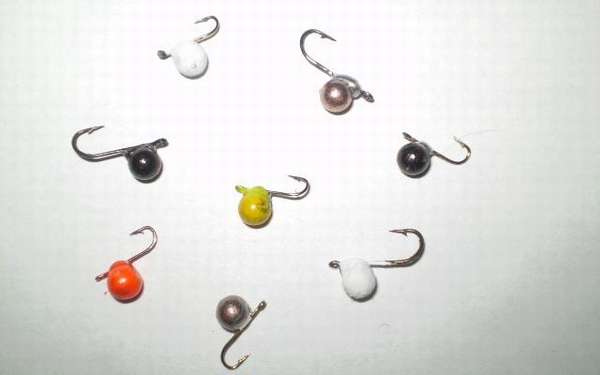
The striped robber is the most common target of ice fishing. Perch prefers jigs in the shape of a droplet, a pellet and any small insect, which is often a type of imitation ant. The optimal size of the simulator should not exceed 4 mm. In relatively calm waters, lead homemade products satisfy this criterion. When fishing rivers with moderate and strong currents, tungsten specimens, which are heavier in mass but identical in size to lead, show the best results. In color schemes, perches prefer dark tones or weights with a shiny surface. Often, the red point of attack in the form of beads, cambric or a piece of thread has a fairly serious effect on the number of bites, which is something you should definitely pay attention to when experimenting with the nozzle when the bite is weak, depressive.
Jig for bream
Bream is considered another coveted ice fishing trophy. As a rule, the larger and heavier the bait, the more you can count on catching a larger bream. Bream loves elongated and elongated shapes of jigs.
Important! It has been noted that the most catchy specimens of bream, those that bring trophy a couple of kilogram specimens into the subglacial standings, are the forms that resemble oatmeal or a grain of oats in appearance.
Breeders will willingly take homemade products in the form of a drop. When hunting bream, you should not additionally load the shank of the hook with beads. Excessive suspicious noise alarms large fish. It is worth paying attention to the colors of bream jigs, which are made in calm natural dark colors. Shiny instruments scare away fish when played.
Jig for roach
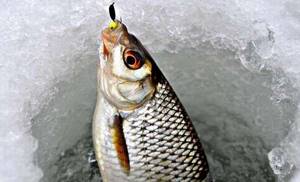
Roach is also one of the most common fish in winter catches. With proper knowledge of the nuances of the Uralka, made with your own hands and a well-chosen fishing spot, even in the dead of winter, the result is significant in terms of the size of the catch. Roach prefers the shape of jigs in the form of insect larvae, painted black. Ant, banana, classic jig are the most attractive types of imitators. The addition of even artificial bloodworms can greatly increase the number of bites. Do not use large-sized products. The roach is much better detected on miniature, tuned homemade products, matching the sound effects that arise when playing from the contact of beads and a hook. A sharp and distinct game attracts fish, so tungsten jigs modernized with luring elements most clearly correspond to the conditions of ice roach fishing.
Jig for crucian carp
Crucian jigs are similar in shape to roach and perch versions of homemade jigs, the only difference is the size of the hook used. The easiest way to make a product is by soldering it in the form of a spherical shape, a droplet or a bug. The black color is suitable for any fishing conditions, including hunting for crucian carp in open water in the summer. Soldering is done on a hook number 12–14 with an elongated shank and a ring-shaped fastening eye. This size and design for fastening allows you to replant animal bait in the form of a panicle of bloodworms, a pair of maggots or a small dung worm, as well as any artificial imitations of these baits made of silicone and securely attach the bait to the main fishing line. It is worth noting that placing bait on a jig hook when fishing for crucian carp is a key point that contributes to the success of the fish approaching the fishing spot and biting it.
DIY jig
There are craftsmen who make baits at a high, high-quality level. The names of these masters are familiar to large fishing circles. Their products are always popular and local fishermen speak of them in legends. Any novice angler can make a jig with his own hands, which is not particularly difficult. Some are quite basic and easily accessible. Here are some of them:
Sawing a jig
Sawing jigs is one of the easiest ways to make a jig. Rods and tubes made of non-corrosive steel, copper, bronze are sawed with a metal jigsaw into a variety of pieces. Hooks are soldered to the acquired figures, after which finishing is done and various coatings are applied. To do this, use various tinsel and colored stickers.
Soldering jig
Using thin plates of tin, sheet copper and other similar materials, you can create jigs of various shapes. A bag, cylinder, or tube of suitable sizes is constructed from foil. A hook is inserted inside these molds and everything is soldered. Foil figures can be easily processed, giving them the most unusual shapes. An elementary example: before creation, a screw is rolled over the foil. This will undoubtedly help create a jig that resembles some insects and their larvae. Filling the resulting grooves with solder and then polishing it will help transform the pattern. Wonderful summer crucian carp jigs are produced by pouring lead into spirals of copper wire, which is also easy to make using a soldering iron. After filling with solder, they are polished until copper ribs appear against the background of lead, which have a copper-red color. Good jigs, similar to pupae of flies, worms and larvae, are obtained by preparing them from copper, bronze, brass, and aluminum wire. It should be quite thin, no more than 0.5 mm thick. Cylinders, bags, worms, etc. woven from such wire. supplied with a hook. It is placed inside these structures and crimped with wire when winding the form. A regular sewing needle is inserted into the ring of the hook to hold the hole when soldering the mold, after which the entire mold is filled with solder. Finishing of the jig involves grinding the purchased workpiece with sandpaper, and then with a felt wheel, until a clear “golden” or “silver” pattern appears on the body of the jig. A similar pattern on the body of the jig makes its play particularly attractive to fish. The grayish background of the solder and the reddish pattern of wire rings are especially valuable when creating summer jigs.
Casting jigs
Casting jigs Casting jigs begins with a blank figure for pouring the liquid alloy.
For this purpose, brick, clay, chalk, alabaster, aluminum and even wood are used. Good effects can be achieved by using copper-graphite brushes (current collectors) of electrical devices and machines to prepare figures. If you can find ones that are suitable in size, allowing you to make recesses of up to 5-8 mm in them, then this greatly simplifies the work. A selection of recesses for the shape of the jig that you like or have invented yourself is made in accordance with the properties of the material used for this. In the case of a copper-graphite plate, brick, or clay, this will not present much difficulty. It is not difficult to find a cutter of suitable hardness and perform this work at a fairly high level. Another thing is making a mold from an aluminum plate. This especially affects some aluminum alloys, which are difficult to distinguish from the outside from a pure alloy, but whose hardness is often very high. In this case, either a sample is made with a drill, or, using suitable sized metal balls from bearings, the molds are squeezed out. By placing the balls between the aluminum plates, the plates are crimped in a table vise. With this method it is possible to produce the most diverse sets of spherical figures. The resulting depressions must be further processed in order to eliminate the resulting edges. This is necessary so that the fusion of the plates is as strong as possible. The easiest way to make molds is from wood. True, they are less reliable. This work is done with a specially made tool, for example, from a drill that has served its life. Its working part, due to its high hardness, will make it possible to easily create samples even in hard wood. Ready-to-use plates with half-molds should fit closely to each other. Having cut two grooves from the edge of the plates (for pouring metal and for releasing air from the mold), you can begin casting jigs. The melted metal is poured into prepared molds. After it has cooled, the plates are separated and the resulting cast jigs are processed clean with a file and sandpaper. Of course, you will ask the question how to tie it? The answer is simple: cut out two blocks, drill holes along the edges, cut out the shape of our future jig from the wire, heat the wire on the fire, insert the wire into a wooden mold, squeeze it and get a mold for casting the jig, see which side is burned deeper, build a slot for the hook so that it lay tightly there, squeeze the two halves and fill it with tin and buy a jig, clean it and make the hole at the angle you need, that’s all.
Designing a jig
From a ready-made branded jig and certain ordinary materials, you can create an entertaining and catchy jig. For example, take a large drop-shaped jig and equip it with a fish cut out of plastic. This stylized fry must have a brilliant color. He plays well on the hook and has the ability to be a catcher under certain conditions. What are these conditions? First of all, the right choice of fishing object. The best use for the jig provided will be for bream fishing. From research it is clear that bream in a flock compete enviously for food. At the slightest opportunity, large individuals push aside the smaller breams and snatch prey right out of their mouths. A small plastic fish, making oscillatory movements at the very hook of the jig, amazingly plays the role of an easy victim of this competition at the feeder. They will certainly try to squeeze it and tear the prey out of its mouth, in this case a hook with a bloodworm. Excellent effects are achieved by coloring jigs purchased or made with your own hands. The jigs are painted with nitro varnishes, for example, nail polish. Its pearlescent tones are especially good when creating perch jigs. The hooks used when designing jigs, since these are usually small hooks, should be checked for the quality of their sharpening using a powerful magnifying glass. It is important that they do not have sharp edges or burrs.
Manufacturing options
There are many ways to make a jig. The choice of one or the other depends on the availability of the necessary tools and materials, as well as on the ability to handle them. Below you can familiarize yourself with the most accessible of them.
Sawing
Sawing is a simple way to make a jig. The materials used are copper, stainless steel, and brass. The tools you will need are a saw, a jigsaw and a file. First, the required shape is cut out of the metal, after which it is sharpened with a file. Next, the process will become a little more complicated, because you will need to attach the form to the hook. This is done using soldering. If you need a small hook for fishing and its eye is sealed, you can make a hole in it for the fishing line using a thin drill.
Video: making a jig at home

Forging
To make tackle using the forging method, you will need a mini anvil and a hammer. The best material in this case is lead. Using a hammer, a metal workpiece is made into the desired shape, after which it is processed with a file. As in the previous case, the hook is soldered to the jig. Before doing this, it is recommended to pinch off the eye and treat the tip of the hook with soldering acid. At the final stage, use a drill to form a hole in the tackle and paint the product in the desired color.
Did you know? According to archaeological data, the first fishing rods appeared approximately 30,000 years ago.
How to solder
Obviously, for this method of making fishing tackle you will need a soldering iron and tin. Working with the tool is quite simple, but increased care is required to avoid getting burned. A simple method is to solder a tin weight onto the hook. To ensure better adhesion, it is recommended to treat the hook with acid before soldering. When the product has cooled, it is given a neat shape with a file.
The next method involves using copper wire with a diameter of no more than 0.5 mm. With its help, turns are formed on the hook, giving the desired weight and shape. After winding is completed, tinning is carried out: a thin layer of molten tin is applied to the product. The final stage will be to bring the surface to a neat final state by grinding.
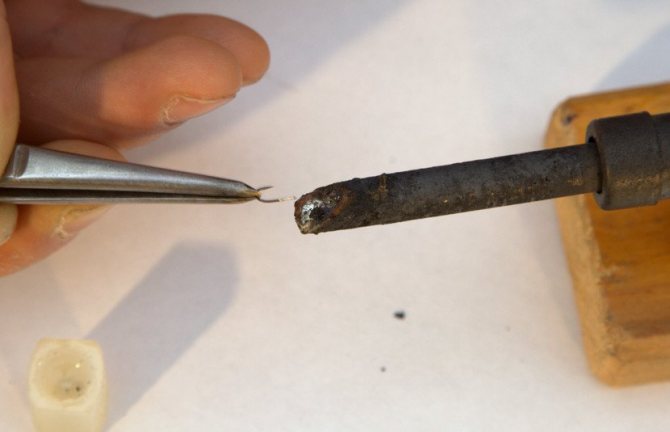
Another interesting, but more painstaking method is soldering using metal strips cut from a tin can. Metal strips are wound around the shank of the hook using pliers, achieving the desired shape and thickness. Then the twist is sealed, and after cooling it is rubbed.
Casting
Casting is one of the most labor-intensive methods. To make gear using this method, lead is mainly used, which melts easily and has good strength characteristics. To create the bait, you first make a two-piece plaster mold. In each part it will be necessary to form an impression that has the shape required from the final product. To do this, you will have to buy a jig or borrow an option you like from another fisherman. You also need to make an impression for the hook and a small recess through which the metal will be poured. When combining two parts, all prints must match.
Important! Lead melts at a temperature of +327
°
C, so extreme care must be taken during casting to avoid serious burns.
You need to immediately insert the hook into the plaster mold. Next you need to melt the lead. At home, you can use a tin can for this. A small groove is made in the side part through which liquid metal will be poured into the mold. It should be noted that lead melts quite quickly on a gas burner. To avoid getting burned during the pouring process, you can use ordinary pliers as a can holder. After the metal hardens in a plaster mold, the product is removed and polished. It can then be painted in the desired color.

Methods for tying a jig
Methods for tying a jig Everyone is familiar with the situation when, after the next hook, a fisherman is left without a trophy and without a jig.
And the point here is often not that a large fish bit, but simply, after several fishing, the line rubbed against the sharp edges in the hole of the jig. The cause of the breakage can be all kinds of burrs. This is especially true for jigs with a brass, copper or other shell, as well as baits made of hard alloys. Therefore, having purchased a batch of jigs - factory-made or homemade, you must first of all carefully inspect the edges of the holes for passing the fishing line. If they are sharp or have burrs, you should do this. Make appropriate recesses in a wooden block, place jigs in them and carefully countersink the holes and then process them. There are several methods, but this is considered the most reliable. First pass the fishing line through the hole of the jig so that the length of the free end is sufficient for tying a knot. Then lay the fishing line in a loop along the shank of the hook and press it with your index and thumb to the shank, but so that between the body of the jig and your fingers there is space for winding the fishing line. With the other hand, make 4-5 turns of the fishing line around the forend, pull the free end of the fishing line into the loop. Holding the winding on the loop with your fingers, grab the main line and tighten the knot. The strength of the knot must be checked.
During the fishing process, the reel can spread. To prevent this, do this: after cutting off the excess fishing line near the knot, be sure to melt the remaining tip with a heated needle at home or over the fire of a match in a pond. After finishing fishing, it is advisable to re-bandage the jig.
Advantages of homemade products
Making jigs at home is not only an interesting and entertaining process, but also provides a number of advantages compared to buying a finished product. Since this type of bait can be safely classified as a consumable item, the loss of purchased tools always causes frustration and irritation. The ability to produce an analogue of a lost homemade product greatly simplifies the replenishment of the fishing arsenal; moreover, during production, most fishermen initially make several baits of the same type for the game.
An important factor is the production of products that are similar in shape, but different in weight, and an already assembled nozzle can always be modified by adding useful additional weight to it or reducing its weight by mechanical processing. In addition to the fact that you can paint the weight in a color that suits special fishing conditions, the bait can be equipped with additional accessories in the form of cambrics and small beads in different quantities, thereby giving the same type of tool different effects in terms of playing parameters and noise design.
Nozzles
For anglers who are just starting to fish with a jig, it is preferable to fish with a nozzle. As a bait, you can use any animal bait that is also used when fishing with a float rod.
I would especially like to note three attachments - bloodworms, maggots and ants. These baits are the most effective when fishing. It is also interesting to experiment with their combinations, the so-called “sandwiches”.
Along with live baits, artificial baits are also often used. Using pieces of dark-colored foam rubber as bait gives very good results. Also, various artificial baits that imitate live larvae can be borrowed from fellow fly fishermen.
Jig color
The color of the bait is an important parameter, especially when fishing at shallow depths. Moreover, in many cases the color of the jig can be decisive. There are a wide variety of, sometimes fantastic, colors of jigs on sale. When choosing the color of the jig, it is important to adhere to the following recommendations:
- For fishing in clear water, cold-colored jigs are preferred;
- Copper-colored jigs have proven themselves to be excellent for deep fishing;
- black baits are considered universal. In spring, black jigs are used more often than others;
- if there is an impressive layer of snow on the ice, use light-colored jigs;
- In the early morning it is better to fish with shiny baits, in the afternoon - with duller ones;
- For night fishing, you should choose jigs with phosphor paint applied to them.
see also
- Balance
- Dialogues about fishing - Issue 020 - Fishing on the Desna. Winter fishing
- Dialogues about fishing - Issue 025 - Fishing in the Middle Volga. Winter fishing
- Dialogues about fishing - Issue 028 - Bleak. Winter fishing
- About Fishing Seriously - Catching perch in winter with a jig
- About Fishing Seriously - Issue 11 - Catching pike perch with a jig
- About Fishing Seriously - Issue 35 - Catching perch with a jig
- About Fishing Seriously - Issue 40 - Winter pike perch fishing
